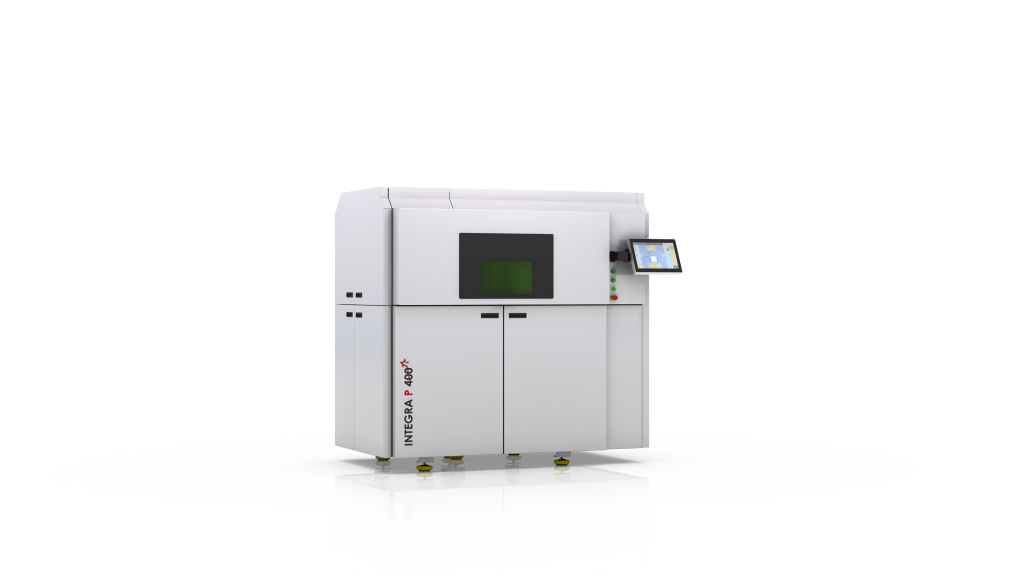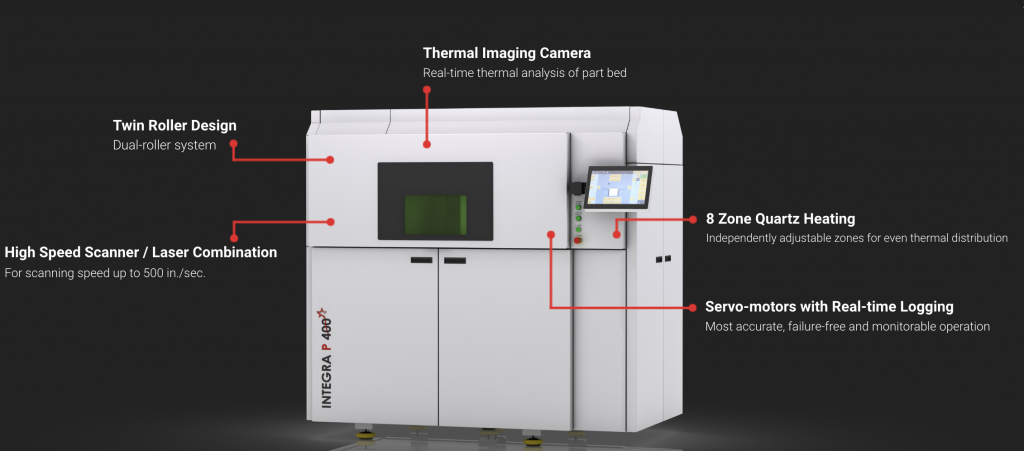EOS is a German firm that does most of its development in Krailling Germany. A few years ago however it acquired ALM a US-based manufacturer of custom selective laser sintering powders. With it came a highly experienced group of industry professionals from ALM and sintering system service subsidiary Integra. Rather than press this team into the German mold EOS seems to have given them the leeway to develop their own laser sintering solution, the Integra P400. I think that this is a profoundly interesting thing to do. Usually, companies are very top down about product development and to let another innovation stream lead to another printer in the same technology is a very interesting move. EOS is very gründlich and very far away from doing things randomly or in a frivolous way. The company must have deep technical and business reasons for letting the US team make its own printer.

If we look at the P400 we can see first off that it looks very different from the regular EOS systems. The fundamental architecture is different also. The P400 is a modular and flexible system that is meant to be customized for particular applications and end-use parts. So one could conceive of a very different P400 for TPU insoles than a system configured for and with modules for PA surgical guides. In actual fact, EOS is responding to market trends here and showing a deep understanding of the industrialization of 3D printing. With its P3XX and P1XX architecture, the company is developing singular production modules that can be dropped into a company to manufacture at scale. The P400 is more of a custom module that can be made to order for one particular application. Both of these options make sense depending on part geometry, throughput and where the company is in their 3D printing industrialization journey. By offering these different architectures EOS seems to be onto a winning strategy here. It also as a firm seems to have swallowed its manufacturing pride and gone with a great additional solution.
Service bureaus want highly productive machines that you can throw any geometry at. But, a manufacturing company is much more limited in the geometric variation of parts. These firms also rarely change materials and do not make a large variety of things. Efficient build volume packing rates, the right scan speed for that part and material and the right settings matter much more to them. These firms have to print to spec and care about scrapping rates and six sigma. They don’t want a “good at everything” solution they want a perfect at one type of thing printer. At high volume applications in aerospace, medical and consumer goods it is the cost picture and the cost per part that really start to become paramount. The P400 seems to have been built to fill this (now small, but not for long) niche perfectly.

With the ALM team on board the P400 can also go way beyond PA to
“high abrasion or chemical resistance, low-temperature performance, high elasticity, and transparency. Built for high-productivity, the Integra P 400’s industry-best scanning speed results from a combination of technologies such as sky-writing, a 120 Watt CO2 laser, and digital galvanometers delivering speeds averaging 12,700 millimeters per second – a 40-50% improvement compared to existing platforms. The new machine also operates at temperatures up to 300°C, and has an innovative recoating system to apply material faster with the flexibility to process a wide range of powdered materials, including high-performance TPU, TPE, and the new HT-23.”
TPU and TPE materials for sintering have a wide array of applications and could very much expand the sintering market to many shoe sole like applications. Additionally high abrasion materials such as carbon fiber filled powders that give higher stiffness for aerospace will expand what is being done with 3D printing in aerospace and defense especially. CRP USA the US arm of CRP Technologies does a lot of manufacturing with automotive parts, especially for autosport. They will be an early adopter for the Integra P400. This in and of itself not only speaks to the seriousness of this as a manufacturing device but also to the future of EOS. CRP also makes its own sintering powders. In the beginning, EOS was completely not open to anyone else’s powder being used on its machines. Meanwhile, CRP also is a user of EOS equipment. Now by including CRP as an early customer EOS in North America at least seems to be more open to other people’s powder on its machines. This will greatly expand the powders on offer for customers. Another launch customer is Honeywell which is very serious about using 3D printing for manufacturing. Immediately my thoughts turn to the fact that traditionally EOS has prohibited using its machines for weapons. This principled stance has cost the company millions but is an ethically very sound move to make. Is the Integra P400 a way around this somehow for the firm? Or will Honeywell use the machines in many of its business units that don’t make defense products?
Stewart Davis, Director of Operations, CRP USA said “At our first evaluation of the Integra P 400, with all of the covers removed, it was clear we were seeing a machine targeted toward our needs. Reliability, serviceability, and material flexibility are all addressed in a straightforward package. We are looking forward to its arrival, and plan to leverage it within our Additive Manufacturing processes to help us continue providing new and innovative solutions to our customers.”
Again the reference of material flexibility here points to a greatly expanded materials portfolio accessibility for the Integra as compared to the other EOS machines. You used to have to pay to get your P100 unlocked, do you now buy an Integra? Reliability is an often touted metric but I’m interested here in the stressing of serviceability. Many 3D printers have been made to sit in universities but service issues have meant that these systems can not be used optimally. If they have a modular service architecture and have been built from the ground up with service in mind I think that this will be a boon for manufacturing firms. Let’s not forget that Integra was a service organization first so the Integra P400 is a 3D printer developed by service people which I think would give us an architecture and usability hereto not present in industrial systems.
“We designed the Integra P 400 to help meet demand for serial production-ready 3D printing in the North American market,” said Michael Conner, Vice President of Service at EOS North America. “The powerful, simple design architecture was developed so one technician with a tool box can service most issues. This simplicity is a key factor that will drive organizations to adopt this new polymer AM platform.”
This easy serviceability with few tools would make servicing machines easier. As importantly it also points to the easier training of maintenance people which is a key bottleneck for 3D printing industrialization.
The specs of the system are:
- Build volume: 420 mm x 420 mm x 500 mm
- Laser type: 120 Watt CO2
- Build Rate: 25 mm/hour (typical)
- Layer thickness: Capability from 0.10 mm to 0.18 mm per layer
- Scanning speed: up to 12,700 mm/s (500 in/sec)
- Twin roller design: dual roller system
- Quick exchangeable laser window
- IR Cameras (real-time thermal imaging of process area): Most accurate, monitorable operation
The scan speed is incredibly high here and points to a different architecture being chosen. The dual roller system would make for less recoating time and the quick exchangeable laser window would speed up maintenance for optics. Real-time laser imaging should mean that this system would have higher control and monitoring of melt pool and across the surface of the chamber. Additionally, the system has “exchangeable frames, exchangeable laser window units, additional multi-box feed system units, and a reduced build volume adaptor that is currently under development. Orders are already being accepted with availability currently limited to North American markets.”
The multi-box feed units would enable higher productivity and the exchangeable window units would allow for faster maintenance. Limiting the P400 to North America is an interesting move but may be a patent issue? Or is it a market development tactic? A very interesting thing is that the machine has “sky-writing, a 120 Watt CO2 laser, and digital galvanometers.” The high-speed digital galvos should make the overall speed and yield of this machine very high indeed and skywriting should make parts very well defined and improve contours. The EOS Skywriting technique equalizes scanning speed as compared to vectoring. With the vector-based scan techniques, lasers speed up and slow down on curves on the contours of parts. A laser scan may speed up at a straight line and slow near a curve for example. This makes parts quite fuzzy looking and impedes their overall accuracy but can be quite fast. With Skywriting the scan speed is equalized across the contour of the part, the laser gate is actually turned off at times as the scanning mirrors continue. Vectoring is kind of like trying to trace a drawing as fast as possible with a brush and slow down when you reach sharp corners. Skywriting is more like trying to trace a drawing at the highest possible overall speed that doesn’t make you mess up the drawing. Skywriting is a big reason why traditionally EOS parts have looked more defined than other SLS parts. Combining Skywriting with high-speed galvos and a large build volume could see this be a real winner for EOS. The added ease of serviceability and modular units that could customize and expand the functionality of the machine for one particular material or application are very exciting. To me this is a very timely market introduction of a potentially fantastic industry customizable workhorse. These are the types of devices that will truly industrialize 3D printing.
Subscribe to Our Email Newsletter
Stay up-to-date on all the latest news from the 3D printing industry and receive information and offers from third party vendors.
Print Services
Upload your 3D Models and get them printed quickly and efficiently.
You May Also Like
The Market and Industry Potential of Multi-Material 3D and 4D Printing in Additive Electronics
Additive manufacturing leverages computer-based software to create components for products by depositing either dielectric or conductive materials, layer by layer, into different geometric shapes. Since its birth in the 1980s,...
3DPOD 262: Bio-inspired Design for AM with Dhruv Bhate, Arizona State University
Dhruv Bhate is an associate professor at Arizona State University. There, he looks at structures, materials, and design. Previously, he worked at PADT as well as in the semiconductor and...
3DPOD 261: Tooling and Cooling for AM with Jason Murphy, NXC MFG
Jason Murphy´s NXC MFG (Next Chapter Manufacturing) is not a generalist service; instead, the company specializes in making tooling. Using LPBF and binder jet, the company produces some of the...
3DPOD 260: John Hart on VulcanForms, MIT, Desktop Metal and More
John Hart is a Professor at MIT; he´s also the director of the Laboratory for Manufacturing and Productivity as well as the director of the Center for Advanced Production Technologies....
































